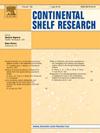十年区域海洋模拟资料同化揭示的渤海冷水团减弱趋势
IF 2.2
3区 地球科学
Q2 OCEANOGRAPHY
引用次数: 0
摘要
利用高分辨率海洋区域环流与潮汐模式(ORCTM)和兼容的集合平差卡尔曼滤波(EAKF)同化模块,研究了渤海冷水团(BHSCWM)的一般演变和长期趋势。通过与多个观测资料的对比,可以证明同化后的模型结果的可靠性得到了显著提高。2011 - 2020年同化结果表明,BHSCWM发生在5 - 8月,其形成与10 m左右深度的季节性温跃层密切相关。中央银行内存在垂直均匀的高温水柱,将BHSCWM分为南段(shbhscwm)和北段(NBHSCWM)。值得注意的是,BHSCWM核心增温趋势明显,shbhscwm和NBHSCWM核心增温速率分别达到0.24°C/yr和0.15°C/yr。与此同时,同化结果显示,无论是从影响面积还是从影响体积来看,渤海冷水质量都有显著减少的趋势,表明全球变暖对渤海冷水质量的影响可能很大。本文章由计算机程序翻译,如有差异,请以英文原文为准。
Weakening trend of Bohai Sea cold water mass revealed by a ten-year regional ocean simulation with data assimilation
The high-resolution Oceanic Regional Circulation and Tide Model (ORCTM) with a compatible Ensemble Adjustment Kalman Filter (EAKF) assimilation module is implemented to investigate the general evolution and long-term trend of the Bohai Sea cold water mass (BHSCWM). Through comparison with multiple observational data, it can be proved that the reliability of model results is significantly improved after the data assimilation. The assimilated results from 2011 to 2020 show that the BHSCWM occurs from May to August, and its formation is closely related to the seasonal thermocline at a depth of about 10 m. There is a vertically uniform high-temperature water column in the central bank, which divides the BHSCWM into the south part (SBHSCWM) and the north part (NBHSCWM). It is noteworthy that there is a remarkable warming trend in the BHSCWM core, the warming rate reaches 0.24 °C/yr and 0.15 °C/yr for the SBHSCWM and the NBHSCWM, respectively. Meanwhile, whether in terms of cold water mass affected area or volume, a significant decreasing trend for both the SBHSCWM and the NBHSCWM is revealed by our assimilated results, suggesting that the Bohai Sea may be dramatically impacted in the context of global warming.
求助全文
通过发布文献求助,成功后即可免费获取论文全文。
去求助
来源期刊

Continental Shelf Research
地学-海洋学
CiteScore
4.30
自引率
4.30%
发文量
136
审稿时长
6.1 months
期刊介绍:
Continental Shelf Research publishes articles dealing with the biological, chemical, geological and physical oceanography of the shallow marine environment, from coastal and estuarine waters out to the shelf break. The continental shelf is a critical environment within the land-ocean continuum, and many processes, functions and problems in the continental shelf are driven by terrestrial inputs transported through the rivers and estuaries to the coastal and continental shelf areas. Manuscripts that deal with these topics must make a clear link to the continental shelf. Examples of research areas include:
Physical sedimentology and geomorphology
Geochemistry of the coastal ocean (inorganic and organic)
Marine environment and anthropogenic effects
Interaction of physical dynamics with natural and manmade shoreline features
Benthic, phytoplankton and zooplankton ecology
Coastal water and sediment quality, and ecosystem health
Benthic-pelagic coupling (physical and biogeochemical)
Interactions between physical dynamics (waves, currents, mixing, etc.) and biogeochemical cycles
Estuarine, coastal and shelf sea modelling and process studies.
 求助内容:
求助内容: 应助结果提醒方式:
应助结果提醒方式:


